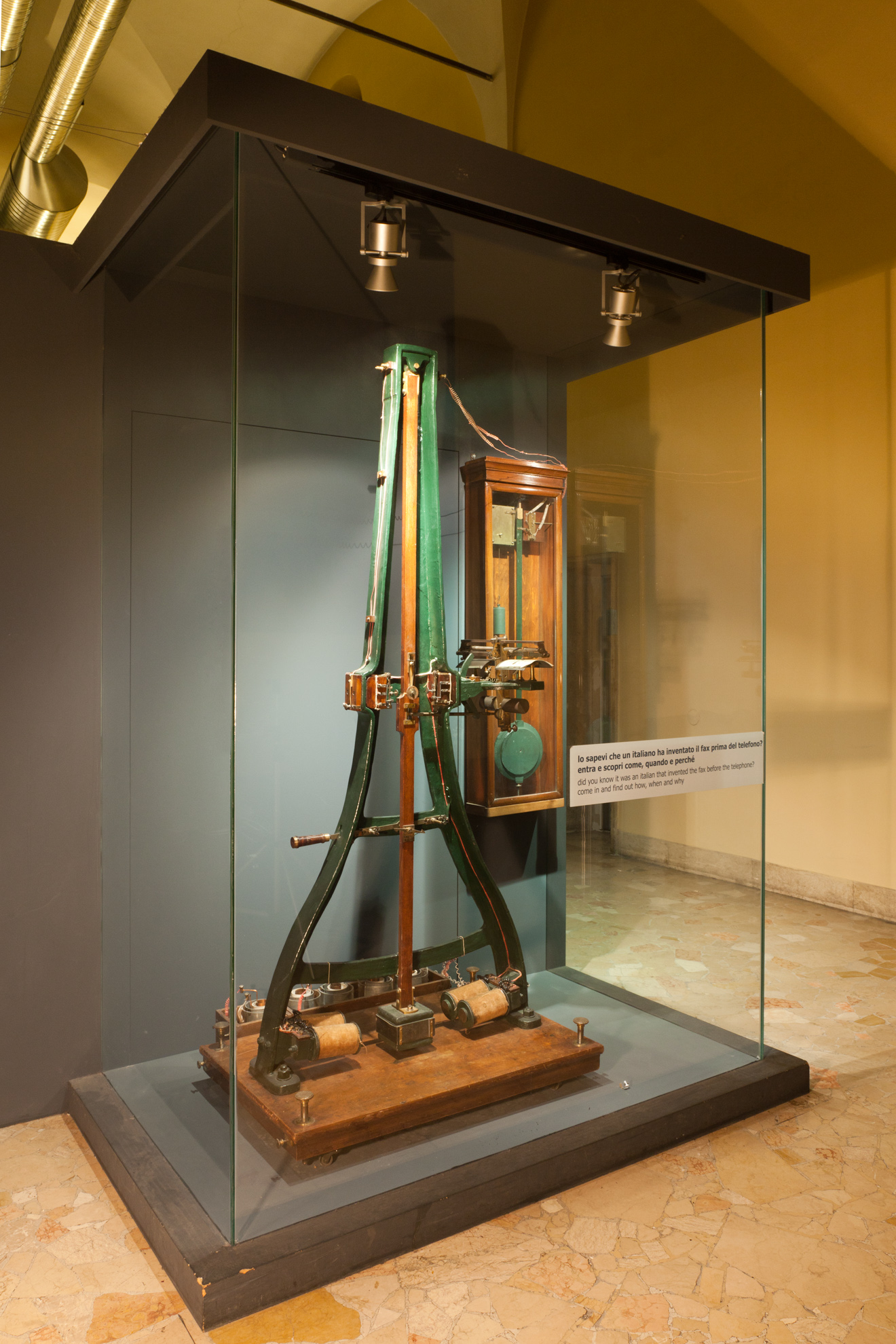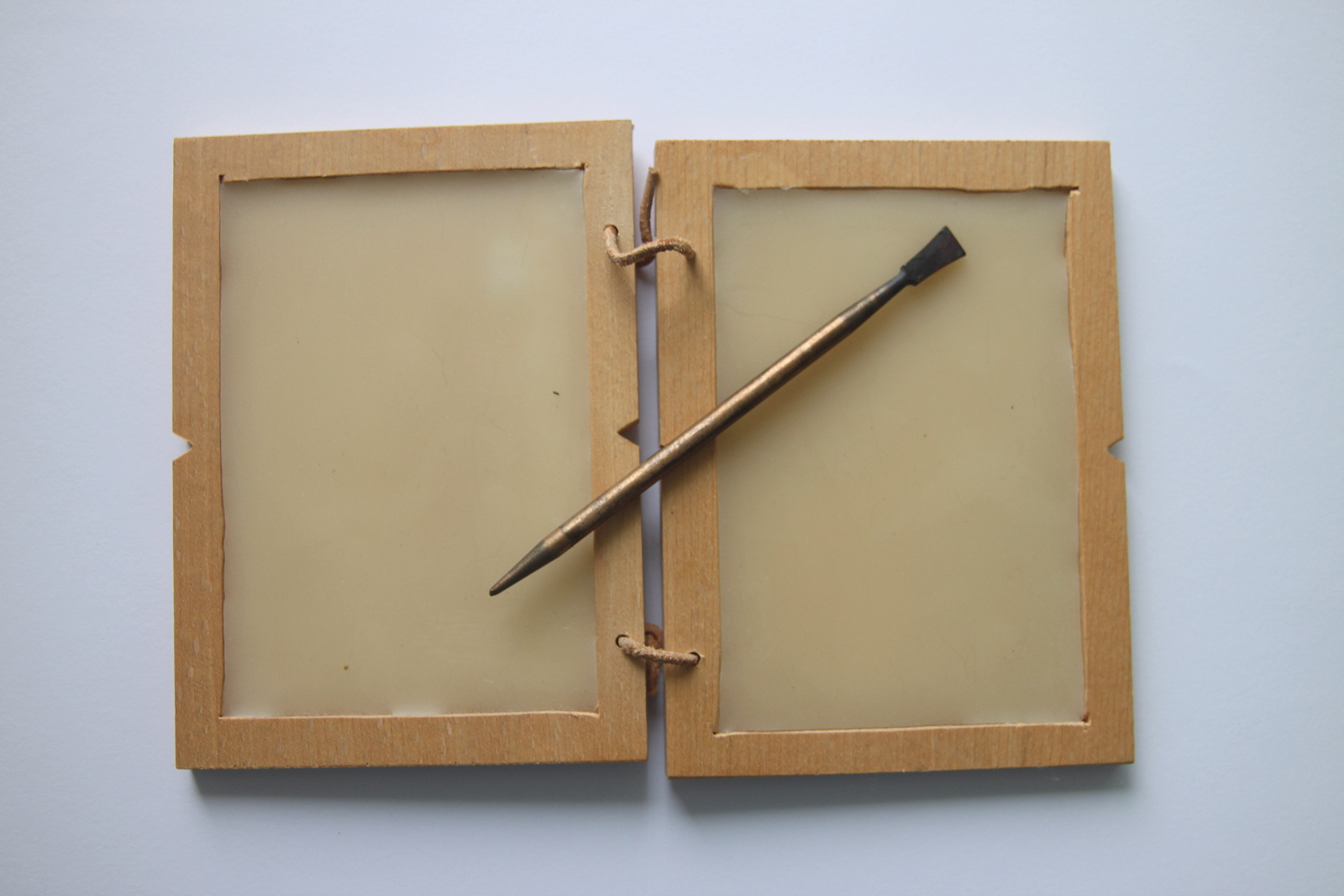|
Giovanni Caselli
Giovanni Caselli (8 June 1815 – 25 April 1891) was an Italian priest, inventor, and physicist. He studied electricity and magnetism as a child which led to his invention of the pantelegraph (also known as the universal telegraph or all-purpose telegraph), the forerunner of the fax machine. The world's first practical operating facsimile machine ("fax") system put into use was by Caselli. He had worldwide patents on his system. His technology idea was further developed into today's analog television. Caselli was a student and professor at the University of Florence in Italy. He started a technical journal that explained physics in Plain English, layman's terms. For his pantelegraph technology he was awarded the Legion of Honor by Napoleon III of France. Parisian scientists and engineers started the Pantelegraph Society to exchange ideas about the pantelegraph and the associated synchronizing apparatus, in order to get the sending and receiving mechanisms to work together properly ... [...More Info...] [...Related Items...] OR: [Wikipedia] [Google] [Baidu] |
Siena, Italy
Siena ( , ; traditionally spelled Sienna in English; ) is a city in Tuscany, in central Italy, and the capital of the province of Siena. It is the twelfth most populated city in the region by number of inhabitants, with a population of 52,991 as of 2025. The city is historically linked to commercial and banking activities, having been a major banking centre until the 13th and 14th centuries. Siena is also home to the oldest bank in the world, the Monte dei Paschi, which has been operating continuously since . Several significant Mediaeval and Renaissance painters were born and worked in Siena, among them Duccio di Buoninsegna, Ambrogio Lorenzetti, Simone Martini and Sassetta, and influenced the course of Italian and European art. The University of Siena, originally called ''Studium Senese'', was founded in 1240, making it one of the oldest universities in continuous operation in the world. Siena was an important city in medieval Europe, and its historic centre is a UNESCO ... [...More Info...] [...Related Items...] OR: [Wikipedia] [Google] [Baidu] |
Insurrection
Rebellion is an uprising that resists and is organized against one's government. A rebel is a person who engages in a rebellion. A rebel group is a consciously coordinated group that seeks to gain political control over an entire state or a portion of a state. A rebellion is often caused by political, religious, or social grievances that originate from a perceived inequality or marginalization. ''Rebellion'' comes from Latin ''re'' and ''bellum'', and in Lockian philosophy refers to the responsibility of the people to overthrow unjust government. Classification Uprisings which revolt, resisting and taking direct action against an authority, law or policy, as well as organize, are rebellions. An insurrection is an uprising to change the government. If a government does not recognize rebels as belligerents, then they are insurgents and the revolt is an insurgency. In a larger conflict, the rebels may be recognized as belligerents without their government being recognize ... [...More Info...] [...Related Items...] OR: [Wikipedia] [Google] [Baidu] |
Newspapers
A newspaper is a Periodical literature, periodical publication containing written News, information about current events and is often typed in black ink with a white or gray background. Newspapers can cover a wide variety of fields such as politics, business, sports, art, and science. They often include materials such as opinion columns, weather forecasts, reviews of local services, Obituary, obituaries, birth notices, crosswords, editorial cartoons, comic strips, and advice columns. Most newspapers are businesses, and they pay their expenses with a mixture of Subscription business model, subscription revenue, Newsagent's shop, newsstand sales, and advertising revenue. The journalism organizations that publish newspapers are themselves often Metonymy, metonymically called newspapers. Newspapers have traditionally been published Printing, in print (usually on cheap, low-grade paper called newsprint). However, today most newspapers are also Electronic publishing, published on webs ... [...More Info...] [...Related Items...] OR: [Wikipedia] [Google] [Baidu] |
Stylus
A stylus is a writing utensil or tool for scribing or marking into softer materials. Different styluses were used to write in cuneiform by pressing into wet clay, and to scribe or carve into a wax tablet. Very hard styluses are also used to Engraving, engrave metal, and the slate and stylus system is used to punch out dots to write in Braille. Styluses are held in the hand and thus are usually a narrow elongated shape, similar to a modern ballpoint pen. Many styluses are heavily curved to be held more easily. The word ''stylus'' is also used to describe Stylus (computing), computer styluses used to assist in navigating or providing more precision when using touchscreens. Etymology ''Stylus'' comes from the Latin —the spelling ''stylus'' arose from an erroneous connection with Greek (), 'pillar'.''Oxford Latin Dictionary'', s.v. "stilus" (2012). The Latin word had several meanings, including "a long, sharply pointed piece of metal; the stem of a plant; a pointed instrume ... [...More Info...] [...Related Items...] OR: [Wikipedia] [Google] [Baidu] |
Tin Foil
Tin foil, also spelled tinfoil, is a thin foil made of tin. Tin foil was superseded after World War II by cheaper and more durable aluminium foil, which is still referred to as "tin foil" in many regions (an example of a misnomer). History Foil made from a thin leaf of tin was commercially available before its aluminum counterpart. In the late 19th century and early 20th century, tin foil was in common use, and some people continue to refer to the new product by the name of the old one. Tin foil is stiffer than aluminum foil. It tends to give a slight tin taste to food wrapped in it, which is a major reason it has largely been replaced by aluminum and other materials for wrapping food. Because of its corrosion resistance, oxidation resistance, availability, low cost, low toxicity, and slight malleability, tin foil was used as a filling for tooth cavities prior to the 20th century. The first audio recordings on phonograph cylinder Phonograph cylinders (also referred to a ... [...More Info...] [...Related Items...] OR: [Wikipedia] [Google] [Baidu] |
Frederick Bakewell
Frederick Collier Bakewell (29 September 1800 – 26 September 1869) was an English physicist who improved on the concept of the facsimile machine introduced by Alexander Bain in 1842 and demonstrated a working version at the 1851 World's Fair in London. Biography Born in Wakefield, West Yorkshire, he eventually moved to Hampstead, Middlesex where he lived until his death. He is buried in a family grave in Kensal Green Cemetery. Bakewell was married to Henrietta Darbyshire with whom he had two sons, Robert and Armitage. Image telegraph Bakewell's "image telegraph" had many of the features of modern facsimile machines. After making several improvements on Bain's design, Bakewell replaced the pendulums of Bain's system with synchronized rotating cylinders The system involved writing or drawing on a piece of metal foil with a special insulating ink; the foil was then wrapped around a cylinder which slowly rotated, driven by a clock mechanism. A metal stylus driven by a ... [...More Info...] [...Related Items...] OR: [Wikipedia] [Google] [Baidu] |
Bain's Facsimile
Bain's Facsimile was an innovative method for transmitting images over long distances, invented by the Scottish inventor Alexander Bain in 1843. Bain's "recording telegraph", as he called it, can be considered the first facsimile machine. This groundbreaking invention is widely regarded as one of the earliest precursors to the modern fax machine, marking a significant milestone in the history of telecommunications. Alexander Bain's facsimile system was a pioneering invention that demonstrated the potential of transmitting images electronically. While it may have been limited in its practical application during Bain's time, its conceptual breakthrough laid the groundwork for the evolution of facsimile technology. Today, Bain's work is remembered as a crucial chapter in the history of telecommunications, showcasing the power of innovation to transform how we communicate across distances. History Alexander Bain, born in 1810 in Watten, Caithness, Scotland, was a prolific inventor ... [...More Info...] [...Related Items...] OR: [Wikipedia] [Google] [Baidu] |
Alexander Bain (inventor)
Alexander Bain (12 October 1810 – 2 January 1877) was a Scottish inventor and engineer who was first to invent and patent the electric clock. He created the first fax machine, known as Bain's facsimile. Bain also installed the railway telegraph lines between Edinburgh and Glasgow. Early life Bain was born in Leanmore, near Watten, Caithness, Scotland. He was baptised in the local kirk on 22 November 1810. His father was a crofter. He had a twin sister, Margaret, and, in total, he had six sisters and six brothers. Bain did not excel in school and was apprenticed to a clockmaker in Wick. Career Having learned the art of clockmaking, he went to Edinburgh, and in 1837 to London, where he obtained work as a journeyman in Clerkenwell. Bain frequented the lectures at the Polytechnic Institution and the Adelaide Gallery and later constructed his own workshop in Hanover Street. Electric clocks and Railway Telegraphs In 1840, desperate for money to develop his inventions, Bain ... [...More Info...] [...Related Items...] OR: [Wikipedia] [Google] [Baidu] |
Portmanteau
In linguistics, a blend—also known as a blend word, lexical blend, or portmanteau—is a word formed by combining the meanings, and parts of the sounds, of two or more words together.Garner's Modern American Usage p. 644. English examples include '' smog'', coined by blending ''smoke'' and ''fog'', and '''', from ''motor'' ('' motorist'') and ''hotel''. A blend is similar to a [...More Info...] [...Related Items...] OR: [Wikipedia] [Google] [Baidu] |
Layman
In religious organizations, the laity () — individually a layperson, layman or laywoman — consists of all members who are not part of the clergy, usually including any non-ordained members of religious orders, e.g. a nun or a lay brother. In secular usage, by extension, a layperson is a person who is not qualified in a given profession or is not an expert in a particular field. The phrase " layman's terms" is used to refer to plain language that is understandable to the everyday person, as opposed to specialised terminology understood only by a professional. Terms such as ''lay priest'', ''lay clergy'' and ''lay nun'' were once used in certain Buddhist cultures, especially Japanese, to indicate ordained persons who continued to live in the wider community instead of retiring to a monastery. Some Christian churches utilise lay preachers, who preach but are not clergy. The Church of Jesus Christ of Latter-day Saints uses the term ''lay priesthood'' to emphasise that its lo ... [...More Info...] [...Related Items...] OR: [Wikipedia] [Google] [Baidu] |








